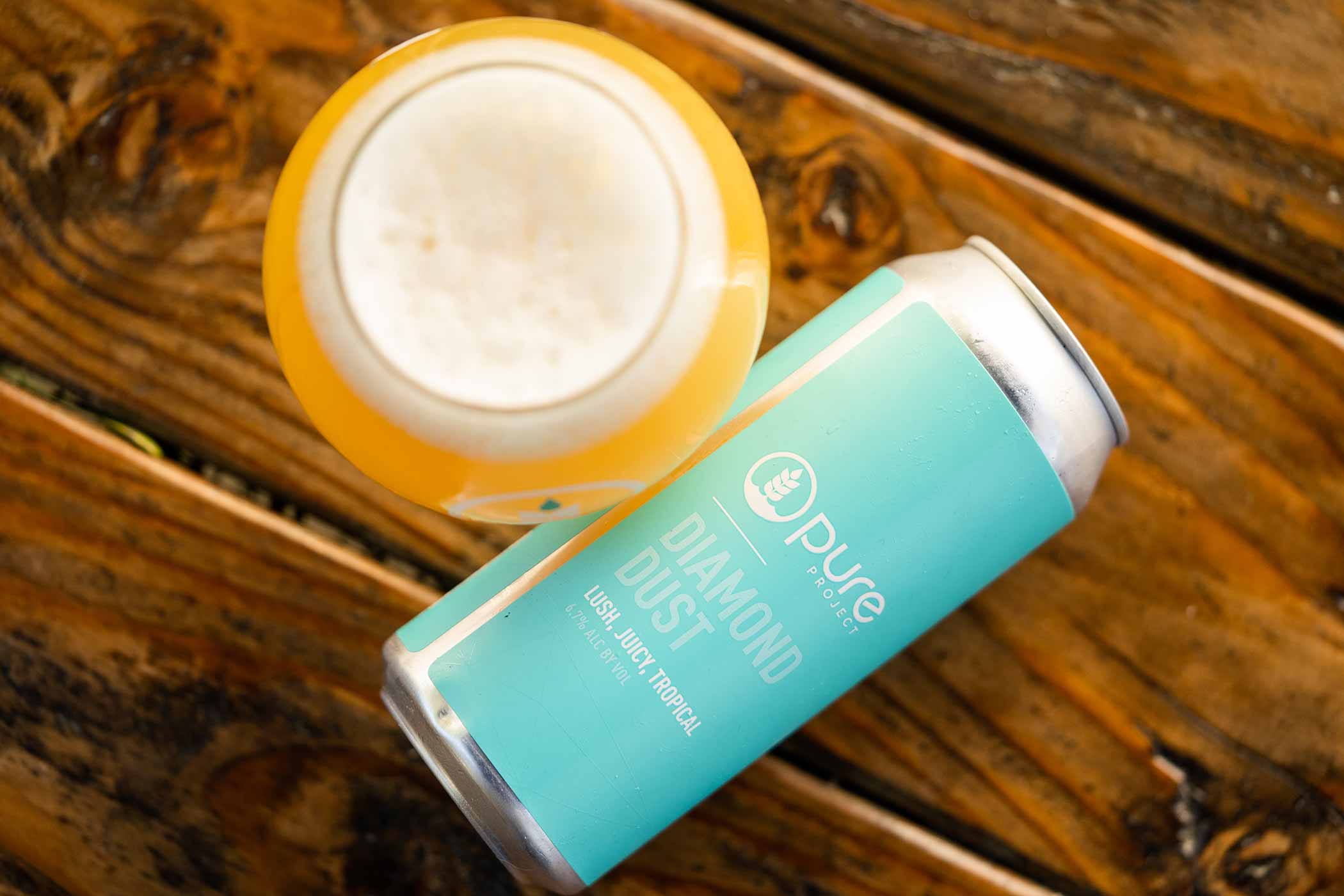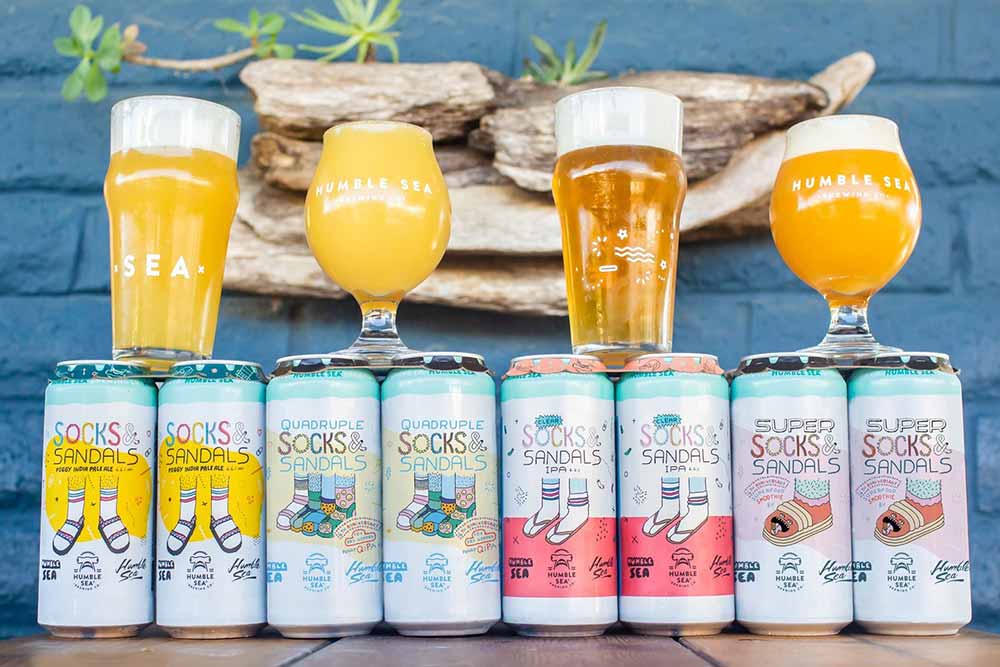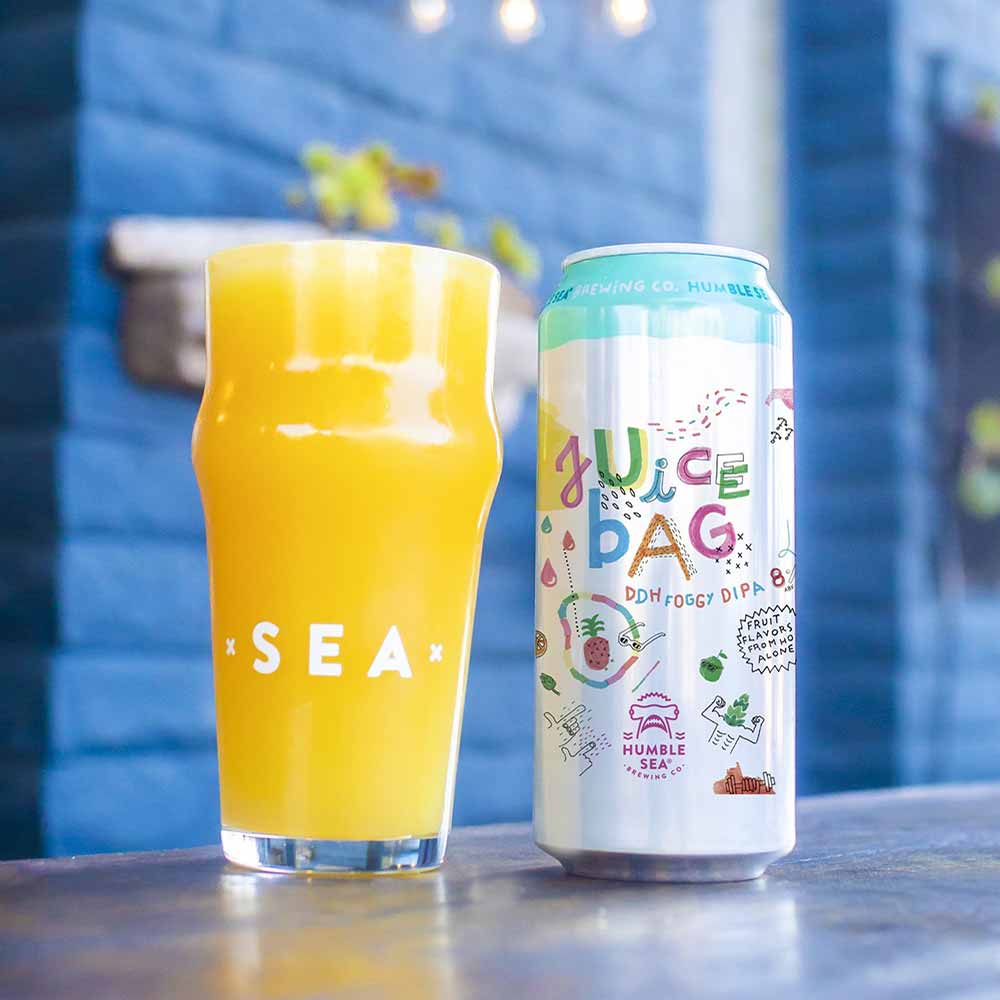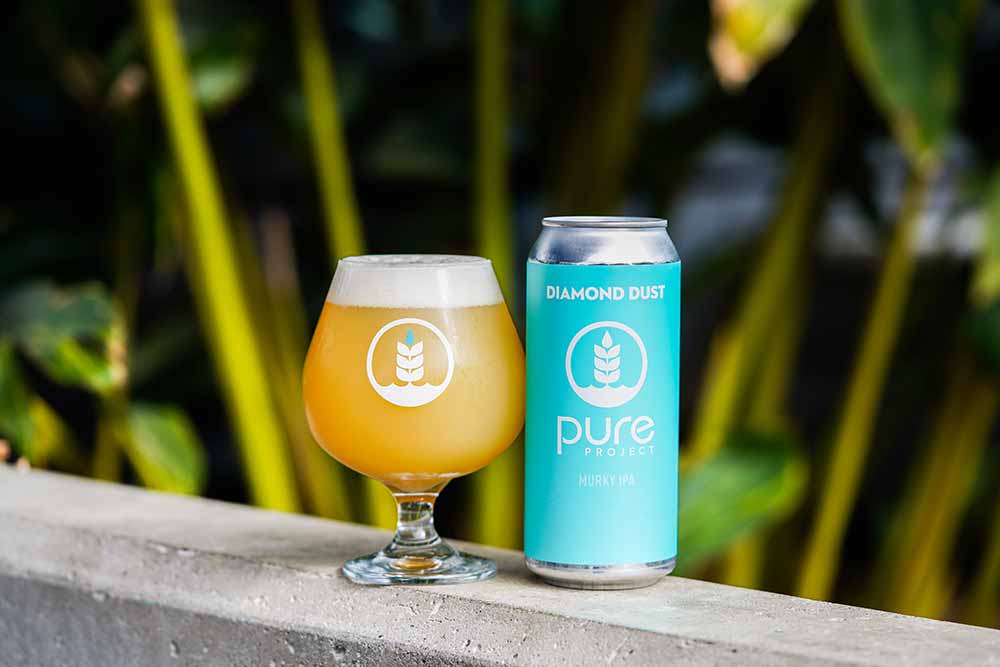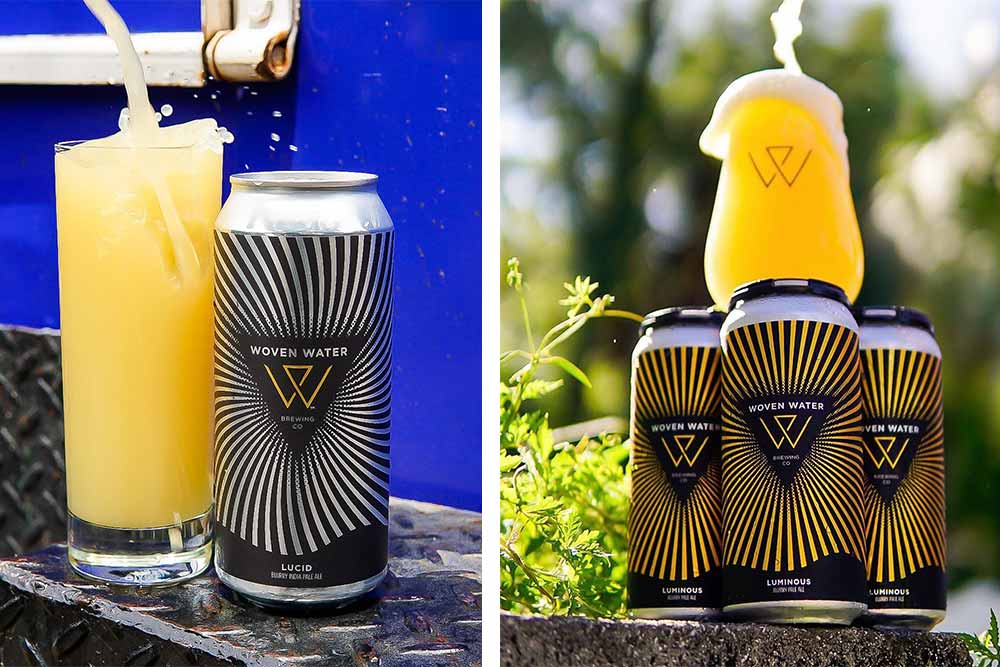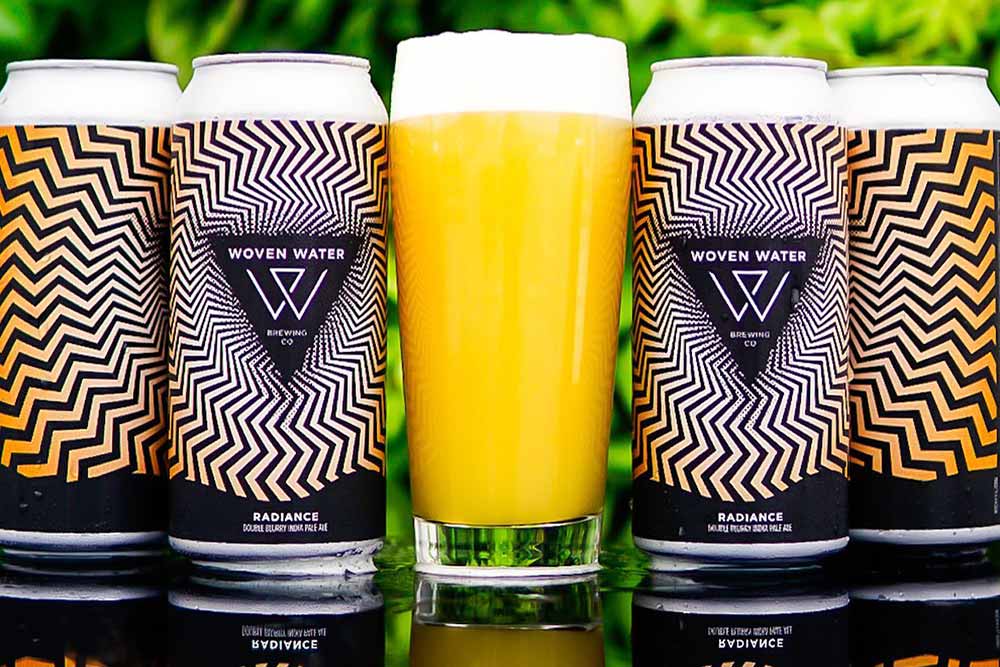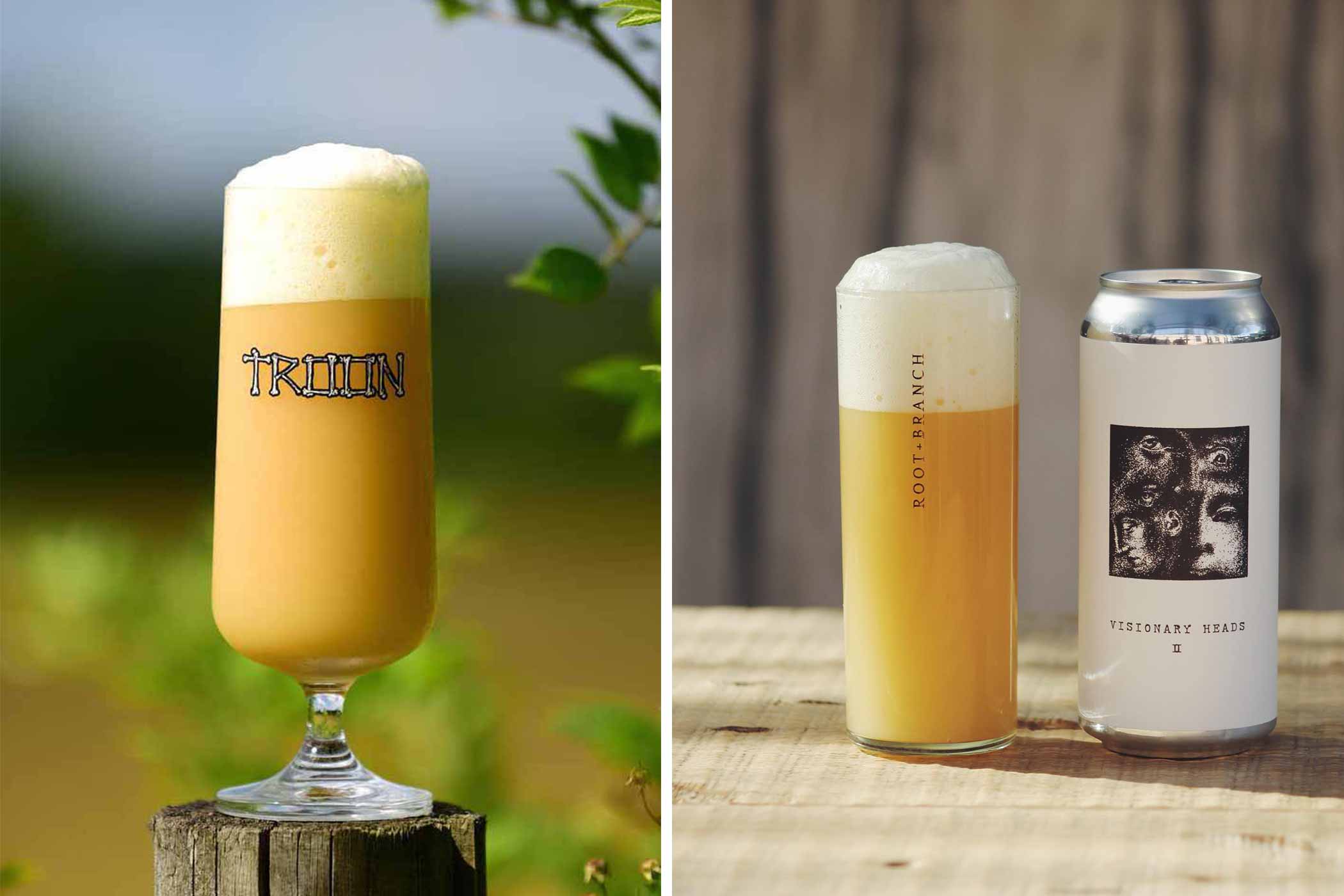Shop
A Hazy by Any Other Name Would Still Smell As Juicy
We ❤️ hazy beer!
Do You Love Hazies? Check Out These Pieces:
When star-crossed lover Juliet proclaims, “That which we call a rose by any other name would smell as sweet,” in William Shakespeare’s play Romeo and Juliet, she’s essentially saying that names mean nothing. Of course, a reference to the historical hatred between the Capulet and Montague households, Juliet’s decree carries on one of the grandest love stories of all time. When New England-style IPAs first hit the market around 2015, people maligned them for their turbidity, starkly contrasting the crystal clear West Coast IPAs on the opposite coast. Something must have been wrong with the beer, right?
Wrong.
Breweries like Tree House, The Alchemist, and Trillium intentionally wanted the light to bounce off these beers, brewing up consistently opaque IPAs that have now become among the top-selling styles in the U.S.
Over time, as peoples’ palates came around to the distinctly juicy, fruity, and uber-delicious notes of a hazy IPA, innovation ensued.
New England-style IPA, again a direct coast-to-coast contrast to West Coast IPA, morphed into the more descriptive hazy IPA.
From there, we’ve heard a hazy called almost everything—turbid, opaque, cloudy, hoppy ales, murky, foggy, blurry.
The latter three have even become core series at Pure Project, Humble Sea, and Woven Water, respectively.
So we have no problem comparing hazies to one of the most prominent plays ever. After all, New England-style IPAs will go down as probably the most significant beer style of our time.
And the name they’ll be remembered by?
According to Juliet, it doesn’t matter, but we thought it would be fun to find out.
Plus, Juliet and Romeo die at the end (spoiler alert), and our love affair with hazies has a very happy ending…at least so far.
Hazies: A Happy Neverending in Craft Beer
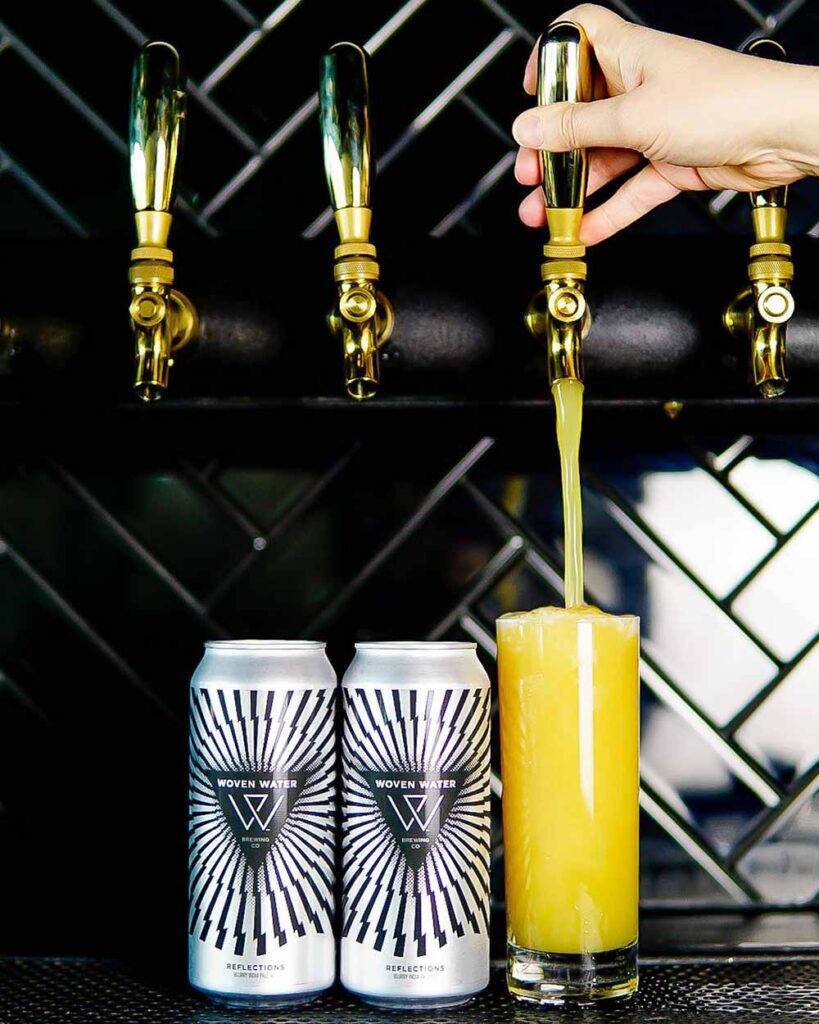
Photography courtesy of @wovenwaterbrewing
Without a seismic shift in sensibilities, which we admit could happen (???? if you’re a Millennial who threw out their Pokémon cards only to learn that they’re now a multi-billion dollar market. Yup, wrong about that one), we predict hazy IPAs will continue to command craft beer.
Just think about it: Why do we love hazies?
A couple of months ago, I gave my wife a hazy (Firestone Walker’s Mind Haze)— the first she’d tried in years. She took a sip, turned to me, and said, ‘Wow, I think I like IPAs now. This beer is just so juicy. It’s almost like a gateway IPA.”
“Welcome to the last decade in craft beer!” I replied.
But it’s true. In 2015, hazies offered something completely different from West Coast IPAs.
Pure Project Founder and Brewer Winslow Sawyer compares the aggressively bitter WCIPAs to spicy food. “If you’re getting spicy food from someone that eats spicy food, it’s going to be way too spicy for someone who’s never eaten that,” he says. “It’s kind of the same thing with IBUs, right? Our idea of balance in a West Coast IPA will be a lot different than a first-time IPA drinker.”
He says hazies weren’t a flash in the pan because they allowed drinkers to experience hops in a different way.
“White IPAs, black IPAs, and Brut IPAs didn’t have … approachable, everyday flavor profiles,” he says. “Whereas tropical fruit juice is something that everyone likes, right!?”
Consider hazies more like an everlasting gobstopper than a chicken wing with that extra dab of The Last Dab hot sauce.
And people fell in love pretty quickly.
“Hazies made craft beer during that time period from 2015-2018,” says Woven Water Co-Founder, Owner, and Brewer Jay Jones. “They’re definitely not going anywhere.”
In 2021, Untappd reported the category “IPA – New England” as the second most checked-in of the year, with just over 6.1 million check-ins.
And last year, although Untappd users decreased those check-ins a bit to just under 6.1 million, it was still good enough to hold the second spot.
But the scales are balancing slightly.
Just ask yourself this question: During the last decade, have West Coast IPAs gone anywhere?
No!
In fact, the only style that has bested hazies on Untappd? American IPAs with over 7.2 million check-ins in 2021.
“Things are much more balanced,” says Humble Sea Co-Founder Frank Scott Krueger, admitting at one point Foggy IPAs, the brewery’s version of a hazy, accounted for ninety-five percent of their production. “That’s definitely not the case at all anymore. Foggy IPA is still our dominant style, but it’s not just insane.”
Sawyer agrees, noting that for something like four years, Pure Project didn’t even brew a West Coast; they only made Murky IPAs, their iteration of a hazy. But now his mind has been more on West Coast IPAs as the brewery again dips its toes into that style pool.
Scott Krueger cites a returning appreciation for West Coast IPA with a slightly new style approach. “West Coast IPAs have evolved with palates,” he says. “They’re still super dry and crispy, but they’re also using newer-school [hops] … and they’ve got a bit of a fruitier profile.”
So as West Coast and New England-style IPAs continue this Capulet-Montague-like tug-o-war, one thing, in particular, has kept hazies a head above the rest—the name.
Do we call a West Coast IPA anything else?
But oh, how the names for hazies have poured out.
Humble Sea’s Foggy IPAs: As Foggy as a Santa Cruz Morning
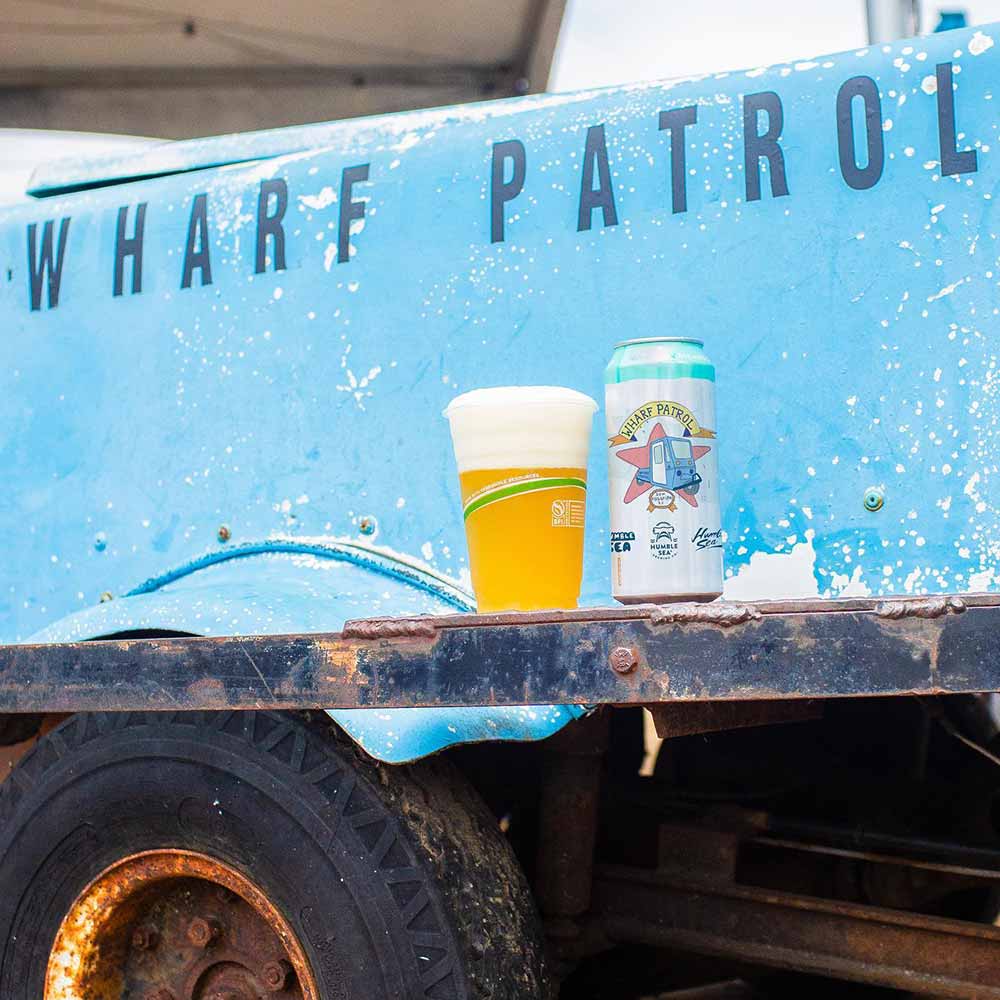
Photography courtesy of @humblesea
If you live in or have been to Santa Cruz, you quickly realize that it’s not actually a very sunny place despite what marketing you may have seen. Like San Francisco, a fog percolates the town for much of the day.
“We thought it would be a funny concept to describe the terroir of Santa Cruz,” says Scott Krueger. “We do kind of love the idea that people come to Santa Cruz looking for fun in the sun … which is hilarious because … it is a very foggy town.”
The chance to come up with a new name for hazies also appealed to Humble Sea’s kooky brand.
“It’s just really fun to invent language around our brand and what we do,” says Scott Krueger. “I always like to joke that we’re trying to start a cult, and inventing unique language around your practices is sort of step one.”
Despite being a bit of a parody, the word “foggy” actually aptly describes a hazy beer.
Can you see through fog? Rarely.
Can you look through a truly turbid beer? Nope.
So when Humble Sea opened in Santa Cruz in 2017, Foggy IPAs seemed like a great fit.
Humble Sea’s First Foggy IPA
Taking a bit of a West-Coast-meets-East-Coast approach to hazies, Humble Sea brews its Foggy IPAs a bit drier with a lower finishing gravity than some counterparts on the other side of the country.
“I think what’s a little different about our approach is we tend to blend … old-school and new-school hops together,” says Scott Krueger. “Often in New England, they’re doing all new-school hops.”
Scott Krueger says they’ll blend in some West Coast classic “C” hops like Centennial, Chinook, and Cascade.
“That’s where we’re from, and that’s what our demographic seems to like,” he says.
For instance, in Humble Sea’s first Foggy IPA, Socks & Sandals. The beer started as just Socks, an experimental Pliny the Elder clone Co-Founder and Brewer Nick Pavlina made in his homebrew days.
Featuring Cascade, Centennial, Citra, and Chinook, Socks became softer with more mouthfeel to create Socks & Sandals. “Still dry, but got that hazy IPA thing going on for it,” says Scott Krueger. “It’s still those same four classic staple West Coast Hops … but now it’s basically fuzzy and as light as possible. Just like milky, straw-colored, and hazy.”
The Fervor for Foggy IPAs
While Socks & Sandals has been a staple from the start, Scott Krueger says, since opening in 2017, Humble Sea has made hundreds of Foggy IPAs. When he last looked, the brewery had brewed over 1,000 unique recipes of all styles, 400 alone just last year, most of those being Foggy IPAs.
“Yeah, absolute s**tload!” he exclaims.
Like Juice Bag, the next step in Humble Sea’s exploration of hazy beer. “We came from a West Coast IPA to using West Coast hops in our Foggy beers, and then Juice Bag was like a full pivot into the juicy territory,” says Scott Krueger, who considers this Foggy IPA a secondary core beer. “We use the word Juice to invoke that feeling and fully lean into that style.”
But those are just two examples of hundreds. In fact, Humble Sea has made so many that Foggy IPAs themselves have overtaken the name hazy, at least locally.
Scott Krueger tells stories about a popular spot in town called Lupolo Craft Beer House. “People come in asking them what are your foggy styles. What do you have that’s foggy?” he laughs. “Which is pretty great because that means our cult is spreading!”
Pure Project’s Murky IPAs: Clear Winners
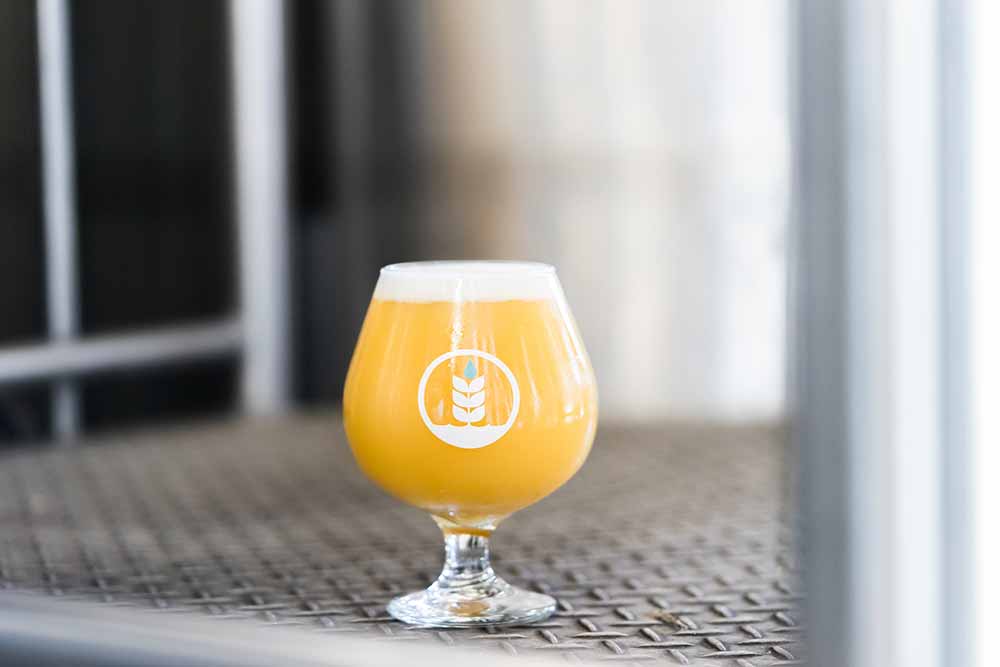
Photography courtesy of Pure Project
Sawyer considers the onset of hazy IPAs a pivotal moment at Pure Project, the San Diego-based brewery focusing on sustainability.
He recalls Pure Projects’ now-Director of Brewery Operations Jensen Atwood bringing in Tree House’s Julius for the team to try. “We were like, oh, man, we should try to make something like this,” says Sawyer.
But up to that point, San Diego had been a staunchly West Coast IPA place.
“The local craft beer culture and brewers themselves were really not into it,” laughs Sawyer. “There were all these things blowing around like hazy is lazy and that they’re gross.”
Following their own tongue-in-cheek approach, Pure Project named their hazy experimentations Murky IPAs to say, “Yeah, it’s gross, but it tastes good,” says Sawyer.
At the time, Pure Project became one of the only breweries in the area, along with Monkish and Modern Times, to brew hazy beers.
For two years, Sawyer and the team tweaked and experimented until they nailed what he calls the brewery’s “house flavor.”
“[Our Murky IPAs] are an expression of the Southern California palate and water,” he says. “Compared to the Northeastern IPA, it’s drier, has more hint of bitterness at the finish, and finishes clean.”
Pure Project Perfects Its Murky IPAs
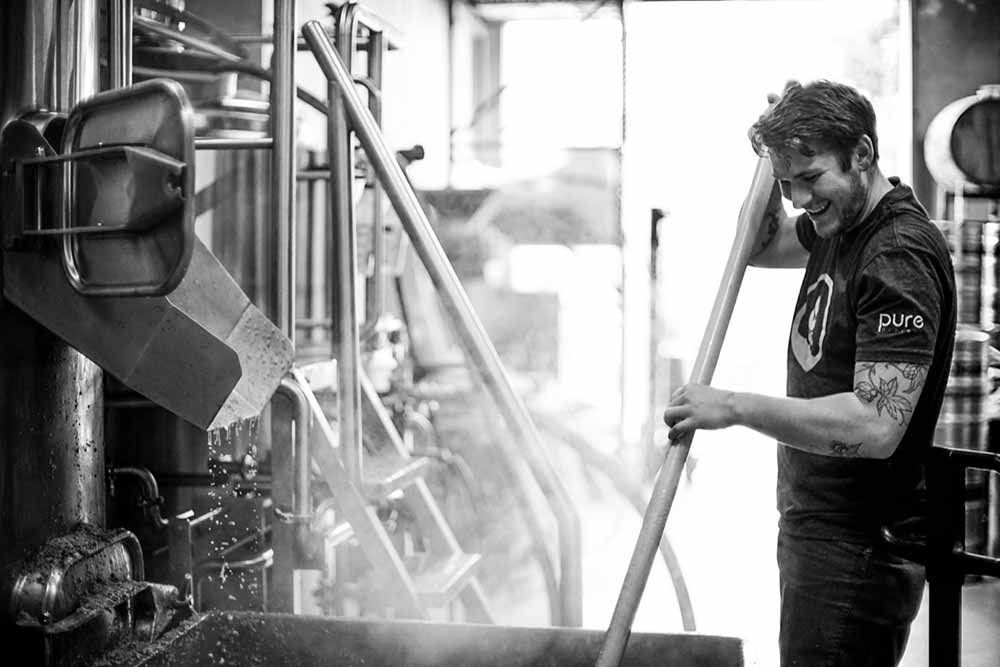
Pure Project Co-Founder and Head Brewer Winslow Sawyer | Photography courtesy of Pure Project
Perfecting Pure Project’s Murky IPAs came down to a few things—water, malt, body, dry hopping, and balance.
Sawyer says the drier, more bitter bite in their Murky IPAs comes in part thanks to the San Diego water, which has high sulfate levels—typically good for a West Coast IPA but not characteristic of the softer water on the East Coast. However, Sawyer says, Pure Project chose not to treat its water to create another West Coast/East Coast hazy blend.
“We definitely wanted to work with the water instead of trying to work against it,” he says. “Our flavor profile is a little drier and a little bit more suited for the sunny, hot climate of sunny San Diego.”
But don’t get it twisted; Pure Project’s Murky IPAs are still expressive of the hazy style.
Starting with a malt bill that includes pilsner malt to make “our Murky IPAs as pale as possible,” says Swayer. “They get this pretty glow to them when they’re light in color.”
Additionally, he adds oats and Patwin wheat, a California-grown unmalted wheat bred at U.C. Davis to be drought tolerant, to help build that body. “We are trying to create that canvas so we can dry hop them more,” says Sawyer.
Finishing at 3.5 Plato, Pure Project’s Murky IPAs stay under four pounds per barrel in the dry hop to prevent “that green hop burn kind of thing,” says Sawyer. “I think that’s lower than some people do, but it seems to work well for our water and making a more balanced product.”
Sawyer considers balance crucial to the brewery’s Murky IPAs. “We want people to drink a full pint instead of like at a bottle share where you’re like, ‘This is super good in a two-ounce serving, but would I drink a pint? I don’t know,’” he says.
Oh, and the beer has to have a very high amount of haze. “We don’t make hazy beer,” says Sawyer. “It’s murky. Like no light bounces off it; it doesn’t go through.”
The First Murky IPA, The Last Laugh
One of Pure Project’s original Murky IPA can releases back in the day, Diamond Dust continues to be a core beer for the brewery.
Sawyer says Diamond Dust is the first Murky IPA he felt where Pure Project dialed in everything. “The flavor profile was right; we were using the right amount of oats and wheat to give that real right flavor, so we kept bringing it back,” he says.
Everyone liked the beer so much that they decided to make it a flagship.
In Diamond Dust, you’ll find pilsner malt, oats, and that Patwin Wheat to “give it this silky body,” says Sawyer. He also uses Mosaic hops from Loftus Farms in the Yakima Valley and, somewhat uniquely, Cashmere hops from Michigan. “They have a really nice coconut note to them that makes the beer stand out,” says Sawyer.
Along with the mango and peach notes from the Mosaic and a bit of orange marmalade from Pure Project’s house yeast, Diamond Dust “has a little small finishing bitterness, and then it’s just clean on the palate,” says Sawyer.
Despite the grumbling in the community around hazies at the time, Sawyer says Pure Project’s Murky IPAs caught on pretty much right from the beginning.
“For a year, we had can releases with lines around the block from people who were in the know and really wanted hazy IPAs, but you couldn’t find them locally,” says Sawyer. “Eventually, once those beers started being shared with your everyday beer drinkers … everyone wanted them.”
At the start, Sawyer says, Pure Project released about three Murky IPAs monthly. “We brewed a lot, like hundreds and hundreds of different ones,” he says.
Everything from quintuple Murky IPAs in the 14% ABV range to those with quirky hops like Wai’iti™ or Nectaron from New Zealand
For instance, Petrified, a double Murky IPA Pure Project released last week with all New Zealand hops like Nelson, Nectaron, and Motueka. “That one is really tasty,” says Sawyer. “It has that nice, really big kind of diesel Nelson note in it, as well as a lot of background, like, fruitiness from the Motueka and Nectaron.”
Years ago, people laughed Pure Project out of town for their Murky IPAs; now, they’re the hottest ticket in town.
Safe to say Pure Project has the last laugh.
“Yeah, I think Murky IPAs are here to stay,” laughs Sawyer.
Woven Water’s Blurry IPAs Blur the Lines
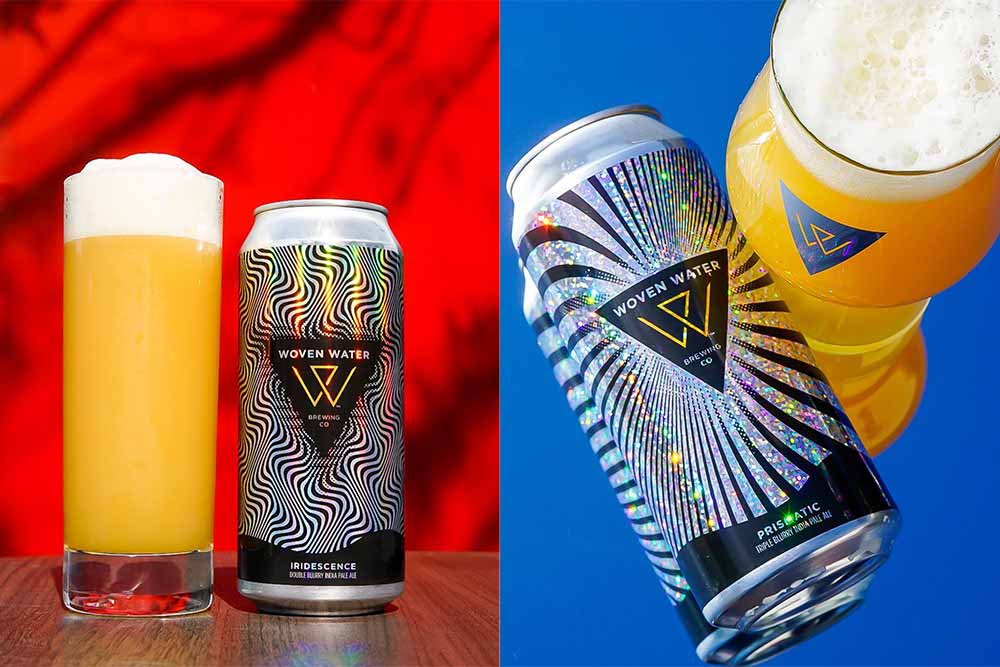
Photography courtesy of @wovenwaterbrewing
On the other side of the country, in Tampa, FL, Woven Water represents a newcomer to the hazy game.
Opening during the pandemic in October 2020, Woven Water embodies the idea that beer is ninety-five percent water with other ingredients woven in.
A big hazy lover, Co-Founder, Owner, and Brewer Jay Jones cites Humble Sea and Pure Project as inspiration for the brewery’s Blurry IPAs.
“We knew, with an ever-changing market of craft beer, we wanted to stand out somehow,” he says. “Everyone called IPAs hazy or juicy or played on New England. Hey, what can we do that’s different.”
At first, the brewery thought of “overcast” IPA because, much like Santa Cruz’s fog, Tampa is actually pretty rainy during the summer, according to Jones. “We weren’t too sold, so what’s a synonym for that?” he asked. “We stumbled on blurry … and ran with it.”
Jones says since the beginning, people have loved Blurry IPAs.
Building Storm Clouds With Woven Water’s Blurry IPAs
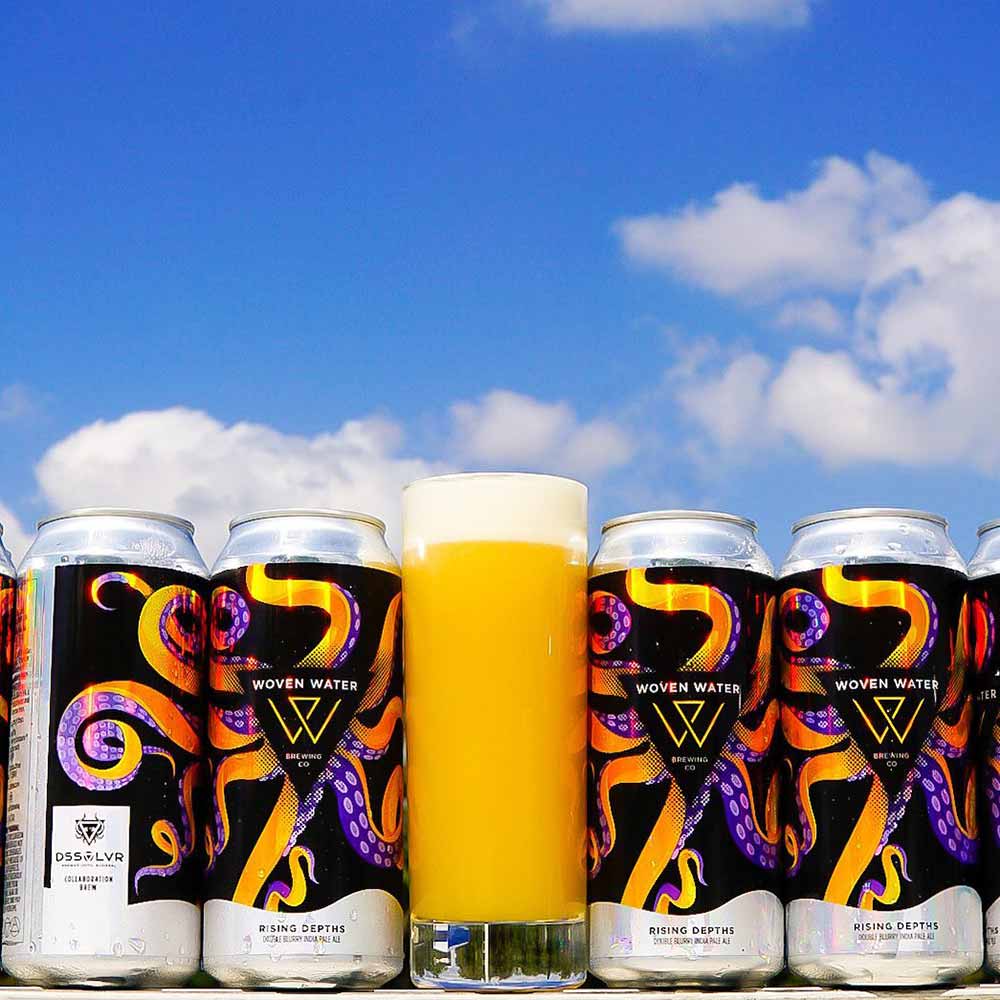
Photography courtesy of @wovenwaterbrewing
Woven Water’s Blurry IPAs encompass anything that falls under a hazy New England-style juicy IPA, whether a pale ale, single, double, triple, or even quad IPA (which Jones says he’ll be attempting next month).
The basics for Jones include “silky mouthfeel is always number one for us,” he says, “And a little bit of sweetness, but not cloying.”
After those two components, Jones says the goal is for the beer to emulate that moment “when you open up that bag of dry hops before you throw it in the beer, and it’s the freshest you’re ever going to smell those hops.”
Jones wants to make each of Woven Water’s Blurry IPAs smell like the freshest hop possible.
Which starts with a super light grain bill followed by a dry hop protocol that rouses hops from the bottom with CO2 daily for three days to “make sure they get back into suspension, so … all of the oils are extracted into the beer,” he says.
Much like how Pure Project experimented for a bit before agreeing on a standard malt bill and process that works well, Woven Water used to deploy a different malt bill for every single Blurry IPA.
Lately, Jones says, they’ve settled into a rhythm of what they know works well—the same percentage of pilsner base malt, oats, and wheat flakes.
Woven Water’s Flagship Blurry IPA + A Few Favorites
In the three years since Woven Water opened, Jones surmises he’s brewed about 120 beers and probably close to thirty Blurry IPAs.
One you’ll always find in the rotation, Lucid became Woven Water’s flagship IPA. “That’s our little baby over here,” jokes Jones, who thinks it was the fourth-ever beer he made at the brewery.
Following a now-familiar grain bill, Lucid has malted oats, wheat malt, and a little bit of wheat flakes layered in, along with a pilsner base malt. “I just find that it ends up being the lightest malt available; that’s the number one thing for us,” says Jones. “I like the backbone it gives—just enough maltiness to know it’s not overpowering the hops.”
Hop-wise, for Lucid, Jones throws Chinook in the whirlpool. “I’ve been a big fan of that because the new-school Chinook has that pineapple characteristic that comes through really well,” he says.
Jones uses Citra and Simcoe for the dry hop, going a bit heavier with the former in what he calls a 60/40 split.
I’ve had plenty of IPAs that also feature those hops, and I’ve just been a big fan, so I was like, well, while we’re doing this, let me just try to do one of my own,” he says.
Although Lucid has been around since day one, Jones says Luminous is probably the best Blurry he’s made.
Actually a Blurry pale ale, Luminous comes in at 5.5% ABV and features Mosaic and El Dorado. “It’s just an absolute crusher of a Blurry,” says Jones. “I love that one because you can drink it all day.”
According to Jones, the pale still has a full-round body and a silky mouthfeel with just a touch of dank Mosaic bitterness to counteract the pineapple, peach, and mango sweetness from the El Dorado hops.
Another Blurry Jones loves, Radiance just dropped a couple of weeks ago.
A new double Blurry IPA, Radiance uses a dry hop Jones hasn’t tried before—Columbus, “to try to achieve a lot more of that dankness—a little bit more resiny and piney—like the old-school kind of West Coast IPAs, but in a Blurry form.”
Combined with Chinook and El Dorado, this new Blurry DIPA “is just full-blown, in-your-face punchy dankness,” says Jones. “But then you actually get a lot of the tropical notes that come through from the El Dorado.
Although newer to the game, Woven Water’s Blurry IPAs have already made an impact. The first day they opened during the pandemic with only drive-thru pick-up, 300 cars came through, according to Jones.
And the name Blurry seems to have stuck.
“It’s funny because we’ll pour some Blurry IPA at a fest, and we literally have people walk up and order a blueberry IPA because they read blurry as blueberry,” laughs Jones. “But for the most part, people are really receptive to it.
For instance, Scott Krueger. “I hadn’t heard of Blurry before, but that’s so good,” he said after Hop Culture shared the name with him. “I love that!”
What Is the Future of Hazies in the United States?
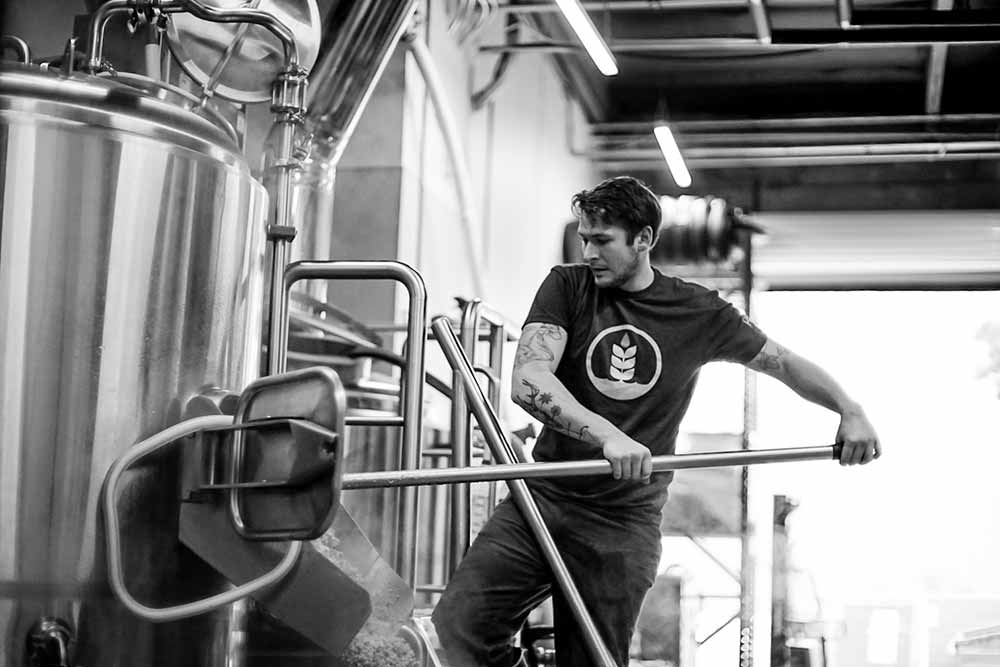
Photography courtesy of Pure Project
Well, hazies aren’t star-crossed. We’ll say that.
While breweries’ portfolios seem to be balancing out, introducing West Coast IPAs back into the fold, hazies (or whatever name you’d like to call them) aren’t going anywhere.
Sawyer says the breweries he’s talked to that aren’t known for hazies have seen their sales drop. “It makes me think that the popular hazy IPA breweries are the ones that people keep going back to get their hazy IPAs, whereas the other ones are going to them for a different product,” he says. “Producers that have cemented themselves as solid, consistent producers of the style are going to be the ones that stick around making large volumes, whereas the other breweries are going to have fun with other beer styles.”
But no matter what you call them—New England-style IPAs, hazies, opaque, cloudy, turbid, foggy, murky, or blurry—a hazy by any other name still smells as juicy.

